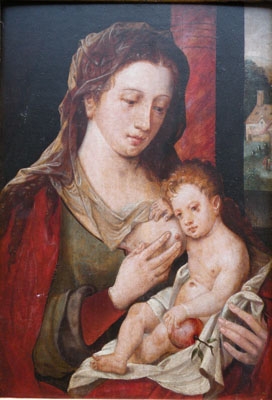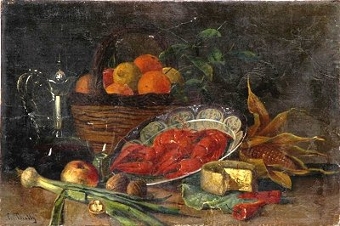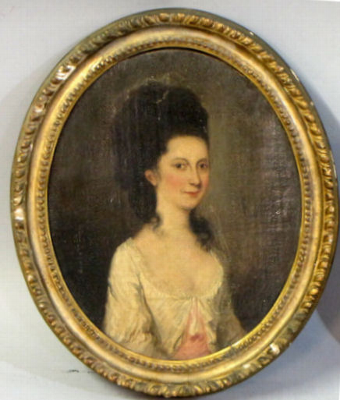featured item
portrait of the veterinary surgeon joseph white holding a tooth extractor
- View other items in:
- antiques interior design modern and vintage
- other interior design
artware ltd
Enquire about this antique
Artware Ltd has 565 antiques for sale.
click here to see them all
Joseph White appears to be holding a pelican, or tooth extractor which may indicate his profession being that of a veterinary surgeon. In the trade directory for melton Mowbray year 1846, there are three vets working in Melton Mowbray in that year one of them being J. White, his name is listed twice in the account book for Fernely. (The John Fernely of melton Mowbray of John Fernely by Guy paget written in 1931.) The Name appears first under no. 78 as the purchaser of a portrait of a horse painting and under no. 254 as the purchaser of a horse painting, also a portrait of himself, that is of J White. At the time Fernely owned two horses as he went hunting with the local hunt and one of the three vets would have had to attend to any horse matters. Fernely was reluctant to paint portraits and only did them if he was pushed and then only to, in most cases people he was closely associated with. With refrence to the pelican which was used to extract teeth, if you scale the toll up it will be some 7 inches long and 3 inches. With refrence to J White working in Melton Mowbray as a Vet in that period, he is in the Wrights business directory for 1848 and he is also in the whites directory for 1846.
John E. Ferneley (18 May 1782 Thrussington, Leicestershire - 1860 Melton Mowbray, Leicestershire), was an English painter who specialised in portraying sporting horses and hunting scenes. Although his rendition of horses was stylised, he is regarded as one of the great British equine artists, second perhaps only to George Stubbs.
At first apprenticed until 1801 to his father, who was a master wheelwright, he was encouraged to take up painting by John Manners, 5th Duke of Rutland. Accordingly he moved to London and studied under the sporting artist Benjamin Marshall. While training with Marshall he joined the Royal Academy School. His work was exhibited between 1806 and 1853 at the Royal Academy. He traveled extensively in Ireland from 1806 to 1809, but returned to England to marry, and started working from Melton Mowbray. Here he built his studio and later a house, Elgin Lodge, on the Sleaford Rd. Melton Mowbray was fast becoming a watering hole for the sporting fraternity and the place where modern fox-hunting developed in the late eighteenth century. Hugo Meynell, a wealthy local bred his hounds to keep up with the horses and riders in their pursuit over hedges and ditches. At this time riders began wearing the scarlet jackets which were to become traditional.
Ferneley''s paintings depicted hunting when it was extremely fashionable. Good horses sold quite readily for 200 guineas and most riders had at least ten in their stables. His work became much sought after, his patrons including many Royals and personalities such as Beau Brummel and the Count d''Orsay. Ferneley routinely was commissioned to paint the famous Quorn, Belvoir, and Cottesmore hunts. The members all contributed to the painter''s fee and then drew lots to determine the winner. Ferneley specialised in painting "scurries", panoramic paintings showing a sequence of events. He befriended Sir Francis Grant and helped him with the painting of horses while Grant in return helped with figure painting. In this way they collaborated on a number of paintings. Ferneley''s signature was done very delicately with a pin head in the wet paint and often hidden on a fence, stable door or in an unexpected corner of the painting. His signature is easily differentiated from that of his son, John Junior, who normally signed heavily in black. Between 1810 and 1812 he visited Ireland twice more, carrying out a great number of commissioned paintings for wealthy Irish patrons. He produced six children with his first wife (who died in 1836) - three of his children later became painters. Ferneley kept a set of account books dating between 1807 and 1860; the detailed notes providing useful material for later historians.
We thank Philip Warren, museum keeper from the Leicestershire museum service for authentication of this portrait.
Antiques.co.uk Ref: F5C52YYG
- Materials:
- Oil on Canvas
- Width (cm):
- 90.00 x 60.00 cm 35.43 x 23.62 ins
Artware Ltd
Artware Fine Art specialises in fine antique, decorative and historical portraits and topographical pictures . We cover a period from the 17th and 18th centuries through to the 19th & 20th Centuries. We have over 150 portraits in stock, which can be viewed on our web site, each historical portrait has well researched biographical information both on the sitter and the artist.
Contact details
18 La gare
51 Surrey row
London
Greater London
SE1 0BZ
UNITED KINGDOM
T: 0207 921 97904
E: greg@artwarefineart.com
W: www.artwarefineart.com












